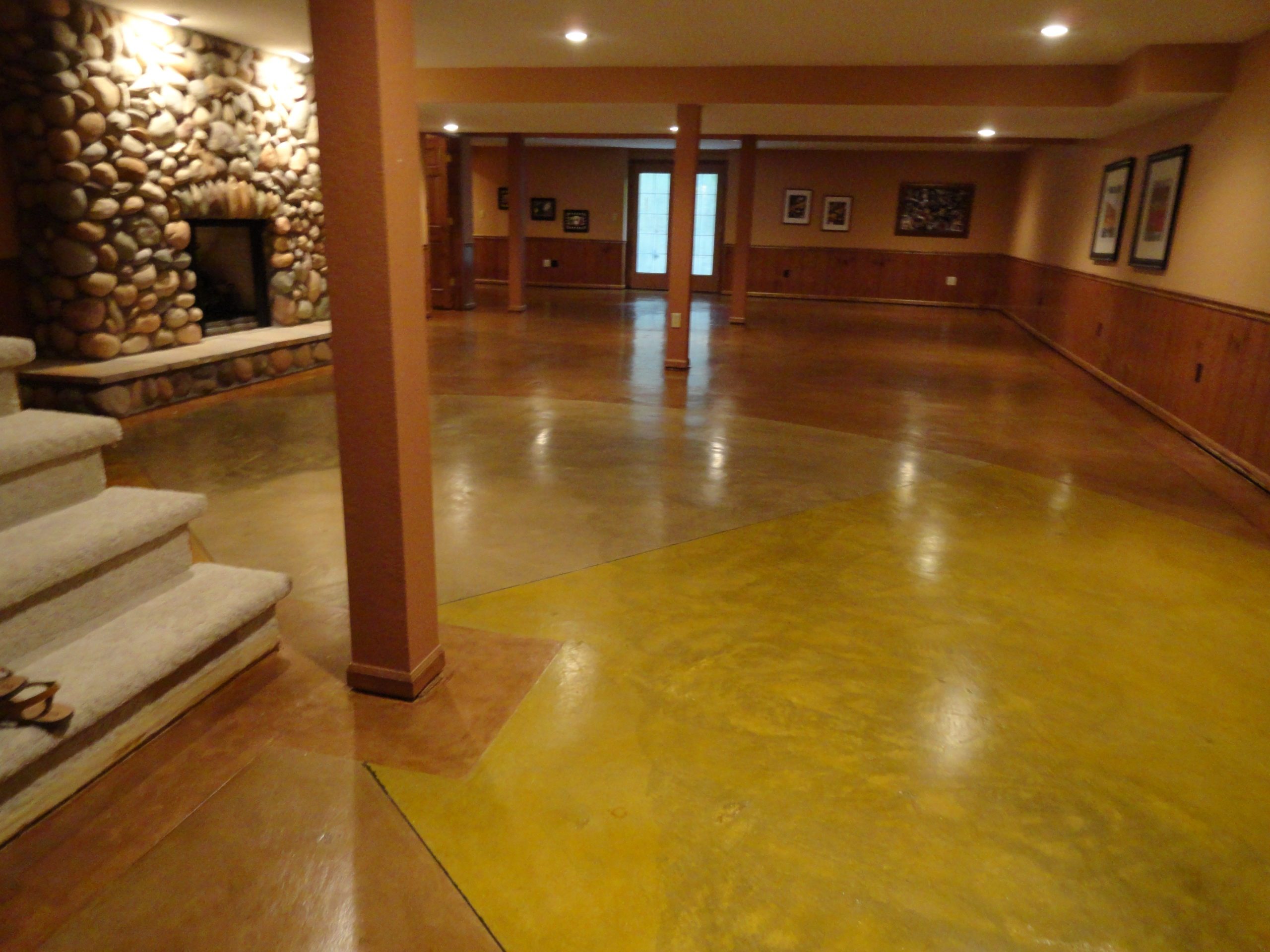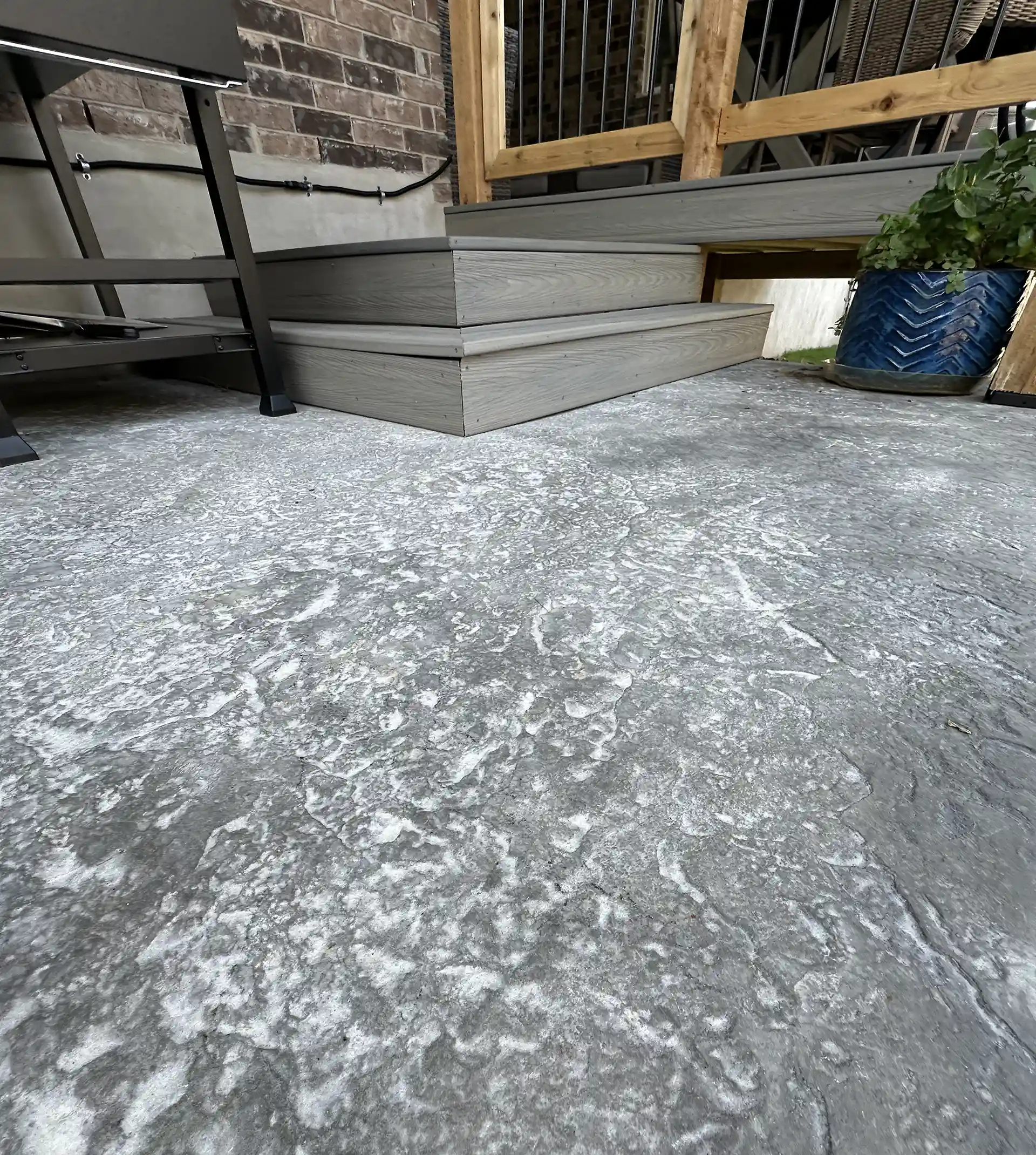Understanding the Various Types of Stained Concrete for Your Next Task
Stained concrete offers various choices that satisfy various visual and functional requirements. Each kind offers distinctive characteristics that affect the final appearance and toughness of the surface. Recognizing these distinctions is vital for anyone preparing a project. From abundant, chemical reactions of acid-based stains to the dynamic uniformity of solid shade stains, the choices can substantially impact the outcome. What aspects should one take into consideration when choosing the perfect tarnish for their specific needs?
Overview of Stained Concrete
Stained concrete serves as a functional floor covering alternative that can enhance the visual allure of numerous spaces. This strategy entails using a coloring representative to the surface area of existing concrete, permitting a broad range of style opportunities. Stained concrete is popular in both household and commercial environments, using a durable and low-maintenance remedy that can mimic the look of natural materials like rock or floor tile.
The staining procedure can be performed using water-based or solvent-based products, each giving distinct visual effects. The last look is affected by variables such as the original concrete surface, the kind of discolor used, and the application approach. Stained concrete not only beautifies exterior and interiors yet additionally advertises sustainability by renewing existing concrete structures. Because of this, it has actually gained traction amongst home owners and developers seeking both capability and style in their flooring options.
Acid-Based Stains: Attributes and Benefits

Special Shade Variations
Concrete surfaces can transform significantly with the application of acid-based stains, which use an abundant combination of unique shade variations. These stains pass through the concrete, responding chemically to create vivid earth tones that vary from deep browns and reds to soft eco-friendlies and blues. The resulting hues are commonly variegated, developing a natural, marble-like appearance that enhances the concrete's personality. Each application yields unique outcomes as a result of variations in the concrete's composition and the staining strategy used, making every job special. Furthermore, acid-based stains can be split or incorporated with other strategies to develop customized designs, enabling personal expression. This adaptability makes acid-based stains a popular selection for both domestic and industrial applications.
Chain Reaction Discussed
While several factors add to the effectiveness of acid-based stains, the underlying chain reaction play an essential role in their one-of-a-kind attributes and benefits. These stains mostly contain water, acid, and metal salts. When applied to concrete, the acid responds with the calcium hydroxide in the concrete, developing a chemical transformation that leads to permanent color changes. The metal salts pass through the surface and bond with the concrete, enabling a large array of shades and tones. This response not only improves visual charm but also provides toughness, making the color immune to fading and wear. In addition, acid-based stains can create a variegated finish that resembles natural rock, more enhancing their popularity for ornamental concrete applications.
Surface Preparation Relevance
Attaining ideal results with acid-based stains depends upon extensive surface preparation. This essential step assurances that the concrete surface is tidy, devoid of impurities, and appropriately profiled for excellent tarnish absorption. Any type of existing sealants, dust, or oils can impede the chain reaction that creates the preferred color and surface, resulting in uneven or patchy results.
Prior to using the tarnish, the concrete must be mechanically cleaned up or pressure cleaned, followed by a comprehensive examination for cracks or blemishes that might need repair. Additionally, confirming the surface area is appropriately dried will enhance tarnish adherence. By focusing on these preparatory measures, the long life and vibrancy of acid-based stains can be considerably enhanced, resulting in a much more visually pleasing and sturdy finish.
Water-Based Stains: Features and Advantages

Water-based stains penetrate the concrete, using a more transparent coating that highlights the natural structure and variants of the surface area below. They are available in a vast array of shades, enabling innovative adaptability in design. In addition, water-based stains are easier to clean up, calling for just water and soap, which streamlines the application process.
Their fast drying out time enhances performance, making them a practical option for both DIY enthusiasts and specialists. Overall, water-based stains give an enticing mix of visual adaptability and user-friendly residential or commercial properties, making them a prominent choice for concrete improvement tasks.
Strong Shade Stains: Dynamic Choices for a Vibrant Look
Strong shade stains use a reliable solution for those seeking to create a bold and vivid visual on concrete surface areas. These stains supply a consistent pigmentation that can significantly enhance the visual charm of floorings, patio areas, and driveways. Readily available in a large spectrum of shades, solid shade stains enable creative expression, dealing with various design preferences.
Among the vital benefits of strong shade stains is their ability to hide blemishes, giving a fresh and refined aim to aging concrete - Stained Concrete Floors Austin Tx. Additionally, their formulation typically consists of UV-resistant homes, ensuring long life and shade retention even in severe climate condition
Application is straightforward, requiring minimal prep work of the concrete surface area. When used, solid color stains can be secured for included defense and shine, further raising their aesthetic top quality. With their dynamic choices, solid color stains are an outstanding option for those going for an impactful and cohesive style.
Semi-Transparent Stains: Attaining Deepness and Dimension
Semi-transparent stains offer an one-of-a-kind method to boosting concrete surface areas by offering depth and dimension with various shade options. Recognizing the application methods is important for attaining the desired effect, while proper maintenance techniques guarantee longevity. This area will discover these essential elements to optimize the benefits of semi-transparent staining.
Shade Options Available
A variety of shade options exists for semi-transparent stains, enabling homeowners and designers to improve the all-natural elegance of concrete surfaces. These stains can be found in a variety of tones, from earthy tones like browns and terracottas to lively shades such as blues and greens. The semi-transparent nature of these stains allows the click this site underlying concrete to show through, creating a special deepness and measurement that can enhance numerous design visual appeals. Furthermore, combining various shades can produce custom shades, enabling a tailored look for each job. This versatility makes semi-transparent stains a preferred selection for both exterior and interior applications, as they can integrate with surrounding aspects while adding visual interest to simple concrete.
Application Techniques Discussed
To accomplish the desired depth and dimension with semi-transparent stains, proper application methods are necessary. Surface area preparation is critical; the concrete should be tidy and totally free of any kind of pollutants. This often includes power cleaning and fixing any fractures. Next, choosing the right applicator, such as a sprayer, roller, or brush, can influence the last look. Sprayers enable for an extra even application, while rollers can help achieve texture. It is necessary to use the discolor in thin, also layers, permitting each layer to dry prior to adding one more. Manipulating the application method, such as varying stress or making use of various devices, can create special effects. Finally, securing the stained surface boosts the vibrancy of the colors while providing defense.
Upkeep Best Practices
Routine maintenance is vital for maintaining the charm and honesty of surfaces treated with semi-transparent stains. To preserve these surface areas, routine cleaning is vital. Utilizing a pH-neutral cleaner and a soft-bristle mop will assist get rid of dirt and particles without harming the tarnish. It is suggested to avoid extreme chemicals, as they can deteriorate the tarnish's look. Additionally, regular resealing each to three years can secure against wear and fading. This procedure entails cleaning the surface area extensively and applying a compatible sealant made for stained concrete. Homeowners Get More Information ought to additionally monitor for any type of indicators of discoloration or damage and address these issues quickly to ensure durable vibrancy and resilience. Complying with these best methods will improve the total life-span of semi-transparent stained surface areas.
Effects and Techniques: Tailoring Your Stained Concrete
Customizing stained concrete involves a selection of strategies that boost both visual appeals and functionality. Among these approaches, layering various discolor colors can create depth and complexity, enabling one-of-a-kind aesthetic impacts. Methods such as acid discoloration supply a variegated look, while water-based stains use a much more uniform look.
Additionally, incorporating attractive patterns, such as stenciling or inscription, can additionally customize the surface, including complex designs that deal with private preferences. Texturing the concrete, whether with marking or mop coatings, introduces responsive elements that not just enhance hold but additionally improve visual interest.
Furthermore, using sealers can intensify the shade vibrancy and give security against wear. Personalization techniques expand beyond plain shade; they can transform a conventional concrete slab right into a stunning focal factor, making it appropriate for both residential and business areas. Via cautious option of impacts and strategies, stained concrete can accomplish a truly customized appearance.
Upkeep and Longevity of Stained Surfaces
Although stained concrete surface areas are understood for their longevity and aesthetic allure, preserving their honesty is necessary for ensuring durability. Regular cleansing is essential; sweeping and mopping with a pH-neutral cleaner assists protect against dust build-up and discoloration. Furthermore, using a sealer every few years can shield the surface area from dampness, chemicals, and UV damage, thereby improving its life-span.
It is likewise important to resolve any kind of cracks or chips promptly. Small repair work can minimize more wear and tear, preserving the visual and architectural top quality of the surface area. For outdoor stained concrete, seasonal maintenance, such as getting rid of snow and ice, is needed to stop surface area damage from freeze-thaw cycles.
Often Asked Questions
Can I Tarnish Existing Concrete Surfaces or Just Brand-new Ones?
The concern of whether existing concrete surface areas can be stained occurs frequently. It is indeed feasible to stain both new and old concrete, offered the surface area is adequately ready and devoid of pollutants for perfect adhesion.
For how long Does the Staining Refine Usually Take?
The staining procedure usually takes one to 3 days, depending upon elements such as surface area preparation, sort of stain, and weather condition conditions. Austin Stained Concrete Floors. Treating time might prolong past preliminary my link application, affecting the overall duration substantially
Is Stained Concrete Safe for Outdoor Use?
Stained concrete is generally secure for outdoor use, gave it is properly secured. This sealing safeguards versus moisture and UV damage, making certain toughness and safety, while likewise boosting the aesthetic appeal of exterior spaces.
Can I Apply Several Discoloration Layers for Various Results?
Applying several tarnish layers can attain varied impacts on stained concrete. Nonetheless, it is vital to ensure compatibility between stains and allow appropriate drying out time in between applications to prevent unplanned reactions or discoloration.
Exist Any Kind Of Shade Limitations for Stained Concrete?
Shade constraints for stained concrete primarily depend upon the type of tarnish made use of, with water-based stains supplying a wider palette contrasted to acid-based stains. Stained Concrete Floors Austin Tx. Achieving lively colors might need cautious option and application techniques.